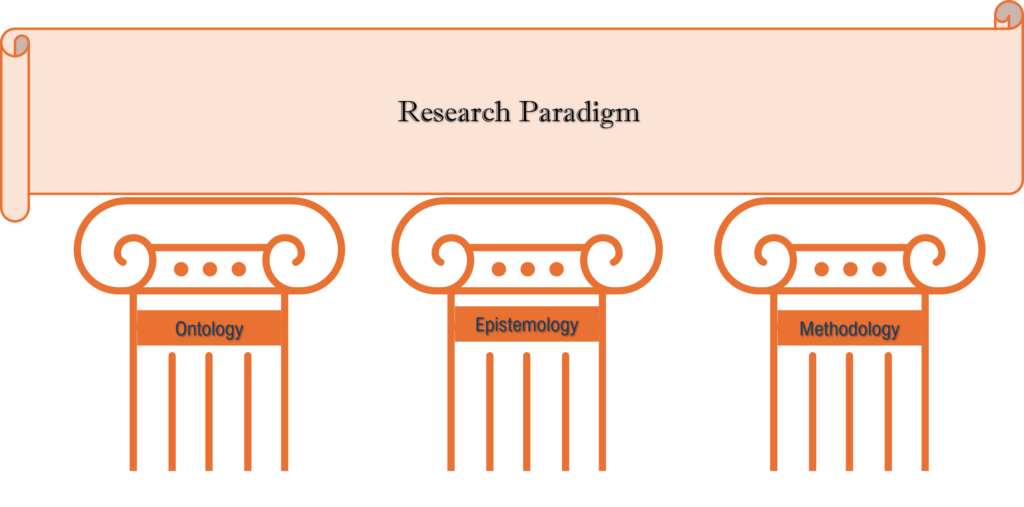Table of Contents
A research paradigm is arguably one of the most complex aspects of research. Have you been wondering what is a research paradigm? Well, this post will demystify this seemingly daunting topic!
A research paradigm is a framework that guides a researcher’s approach to an investigation and thus helps the researcher shape the development of knowledge. The purpose of research paradigms is to serve as the foundation for how research questions are formulated, data are collected, and findings are interpreted.
Simply put, a research paradigm is a construct that helps you organize your research plan. It simplifies the understanding of how the reality, theories, and methods in your project connect and function. In this post, you will learn about the types of research paradigm, research paradigm examples, and more.
What is a Research Paradigm?
Research paradigm definition: A general worldview or philosophical approach that shapes how researchers think about knowledge, reality, and the world. Another research paradigm definition is a “set of common beliefs and agreements shared between scientists about how problems should be understood and addressed.”
It influences everything from problem identification to methodological choices and data interpretation, encompassing the following:
- Fundamental assumptions about the nature of reality (ontology)
- Beliefs about what constitutes valid knowledge and how it can be acquired (epistemology)
- Values that guide the research process and ethical considerations (axiology)
- Methodological approaches deemed appropriate for investigating phenomena.
The Three Research Paradigm Pillars
A research paradigm can be visualized as being held up by three “pillars,” namely, ontology, epistemology, and methodology.
- Ontology: Ontology is concerned with the nature of reality. It addresses whether reality exists as a single objective truth (realist ontology) or as multiple subjective constructions shaped by individual perspectives (relativist ontology). Researchers must determine if their field of study contains fixed, discoverable truths or contextual, interpreted realities, as this assumption influences the research approach.
- Epistemology: The study of knowledge, i.e., how we know what we know and how we validate that knowledge. Epistemological positions include: (1) objective knowledge obtained through precise measurement, (2) partial knowledge constructed through individual perspectives, or (3) dynamic knowledge that constantly evolves. A researcher’s epistemological stance determines whether they pursue objective facts through quantitative methods or subjective understanding through qualitative approaches.
- Methodology: The systematic approach to investigating reality and validating acquired knowledge. Methodology translates philosophical positions into practical research designs, determining specific data collection and analysis techniques that align with the researcher’s ontological and epistemological assumptions.
While ontology, epistemology, and methodology are the three main pillars supporting a research paradigm, a fourth pillar might be axiology. Axiology deals how a researcher’s perspectives and values can shape how the research is designed and findings are interpreted.
What is the Purpose of Research Paradigms?
Selecting an appropriate research paradigm is essential as it directs every aspect of the research journey. The paradigm serves as the philosophical foundation that determines how questions are formulated, methodologies are selected, and findings are interpreted. Beyond these technical elements, it influences the researcher’s relationship with the subject matter, ethical framework, participant interactions, and ultimate research objectives.
Researchers who carefully identify and adopt an appropriate paradigm ensure their work maintains philosophical coherence with methods that align with their views on reality (ontology), knowledge acquisition (epistemology), suitable approach (methodology), and even value systems (axiology). Thus, the purpose of research paradigms is to set the stage for research that is not only methodologically sound but also philosophically consistent and meaningfully connected to the researcher’s worldview.
Types of Research Paradigms
Research paradigms are of several types. We will discuss the salient ones here.
- Positivism paradigm: In the positivism paradigm, a single, measurable reality is assumed, which is studied through quantitative methods. The researcher emphasizes empirical observation, and logical reasoning, and the researcher is viewed as independent.
- Postpositivism paradigm: The postpositivism paradigm is similar to positivism but acknowledges that complete objectivity is impossible. Here, researcher biases and influences are recognized, and efforts are made to minimize them.
- Constructivism paradigm: Constructivists see reality as subjective, shaped by individual and social contexts. They focus on how people construct meaning, valuing reflexivity, ethical responsibility, and co-created knowledge to drive social change.
- Interpretivism paradigm: In this paradigm, subjective realities are studied by exploring individuals’ lived experiences and meanings. Researchers immerse themselves in participants’ perspectives, prioritizing deep, empathetic understanding.
- Pragmatism paradigm: Pragmatists choose methods based on the research question, combining qualitative and quantitative approaches. They prioritize practical outcomes over fixed realities, balancing subjective and objective perspectives.
- Critical realism paradigm: This paradigm assumes objective but layered reality, influenced by societal power structures. Critical realists advocate for critical reflection on researcher biases while seeking to understand and transform social conditions.
- Critical theory paradigm: This paradigm prioritizes social transformation and marginalized perspectives.
How to Choose a Research Paradigm
We just read about the different types of research paradigms. But what is the best one for you? The choice of research paradigm hinges on aligning the study’s objectives, questions, and the nature of the research problem with the underlying philosophical assumptions. Each paradigm shapes how researchers frame questions, collect data, and interpret findings.
Here is how you can go about choosing a research paradigm:
- Start by clarifying the ontological (nature of reality) and epistemological (nature of knowledge) foundations of your inquiry. For instance, a quantitative paradigm rooted in positivism suits hypothesis testing and generalizable findings, while qualitative approaches under interpretivism explore subjective experiences and social contexts.
- Consider disciplinary norms, e.g., fields like psychology often favor empirical methods, whereas anthropology may prioritize ethnographic techniques.
- Evaluate whether your aim is theory-building (qualitative) or theory-testing (quantitative), and ensure your methodology coherently reflects these choices.
Combining Research Paradigms
Some studies even blend paradigms (e.g., pragmatism), while others strictly adhere to just one. Combining paradigms, such as through mixed methods, is advantageous when addressing multifaceted research problems requiring both numerical trends and contextual depth. The pragmatism paradigm, which prioritizes practical outcomes over rigid philosophical alignment, allows the integration of quantitative surveys and qualitative interviews. Transformative paradigms also support combining methods to address power dynamics or social justice goals, ensuring diverse perspectives enrich the findings. To maintain methodological rigor and coherence, it is important to justify the integration strategy.
Comparing Research Paradigms
The table below provides a quick and easy way to grasp the differences among various types of research paradigms, comparing them in terms of the three pillars, ontology, epistemology, and methods.
| Paradigm | Ontology | Epistemology | Methods
|
|
| Positivism | Objective, singular, measurable | Empirical observation; quantitative data | Experiments, surveys, statistical analysis | |
| Postpositivism | Reality exists but is imperfectly knowable | Probabilistic; combines empirical and critical logic | Mixed methods (quantitative + qualitative) | |
| Constructivism | Subjective, socially constructed | Co-created through interactions; context-dependent | Interviews, ethnography, case studies | |
| Interpretivism | Subjective, multiple realities | Understanding lived experiences and meanings | Phenomenology, narrative analysis | |
| Pragmatism | Practical, problem-centered | “What works”; truth in utility | Mixed methods (flexible to research goals) | |
| Critical realism | Layered reality (observable + hidden) | Subjective interpretation of objective structures | Mixed methods, case studies, critical analysis | |
| Critical theory | Shaped by power and inequality | Knowledge as a tool for emancipation | Participatory action research, discourse analysis |
Table 1: A comparison of research paradigms
Research Paradigm Examples
To understand the differences and purpose of various types of research paradigms, let’s now examine some research paradigm examples.
Positivist paradigm
- A study measuring the impact of a new fitness regimen on geriatric performance using statistical analysis.
- Studying the effect of a drug on patient recovery using controlled trials.
Postpositivism paradigm
- Investigating the effectiveness of a new drug for treating a rare disease in a double-blind randomized controlled trial, along with collection of qualitative feedback from patients regarding the side effects.
Constructivism paradigm
- Using in-depth interviews and narrative analysis to exploring how teenagers construct their identities as influencers across social media platforms.
Interpretivism paradigm
- Understanding how prison inmates perceive the benefits of regular yoga classes.
- Exploring how teenagers perceive the value of collaborative learning.
Pragmatism paradigm
- Studying the effectiveness of a climate advocacy program by combining surveys and focus groups.
- Assessing a public health awareness campaign using surveys and focus groups.
Critical realism
- Examining the causes of cybercrime in small towns, using statistical data to identify patterns, while also conducting interviews to uncover deeper mechanisms that are not directly observable.
Critical theory
- Analyzing how climate change coverage in the media affects perceptions of naysayers; the research critically examines the narratives, language, and images in mainstream media to uncover hidden ideologies and promote change.
Transformative paradigm
- Studying health outcomes in a marginalized indigenous tribe by partnering with the community and local leaders for public health awareness. The researcher follows participatory action research, where community members co-create survey questions and interpret findings. Besides observations, the goal is to empower the community and drive social change.
Five Steps to Shift Paradigms
Now let’s look beyond research per se. As a researcher, you operate within personal frameworks of beliefs, habits, and behaviors. Have you ever paused to wonder how these might influence your work? Here is how you can consciously examine and adjusting your own paradigm:
- Identify beliefs or habits that may be stifling you or hindering your research or growth
- Define clear goals and specific outcomes
- Reframe your mindset
- Actively align your thoughts with your goals through journaling, inspiring content, or networking with supportive peers
- Challenge yourself with new activities and approaches. Reinforce new behaviors and be consistent!
By intentionally reshaping your paradigm, you can enhance both your research and personal development!






